“来往”系列作品
"The Coming and Going" Series
-
2020
参与式艺术
Social Participatory Art
项目地:中国重庆
Located: Chongqing, China
Award: 重庆
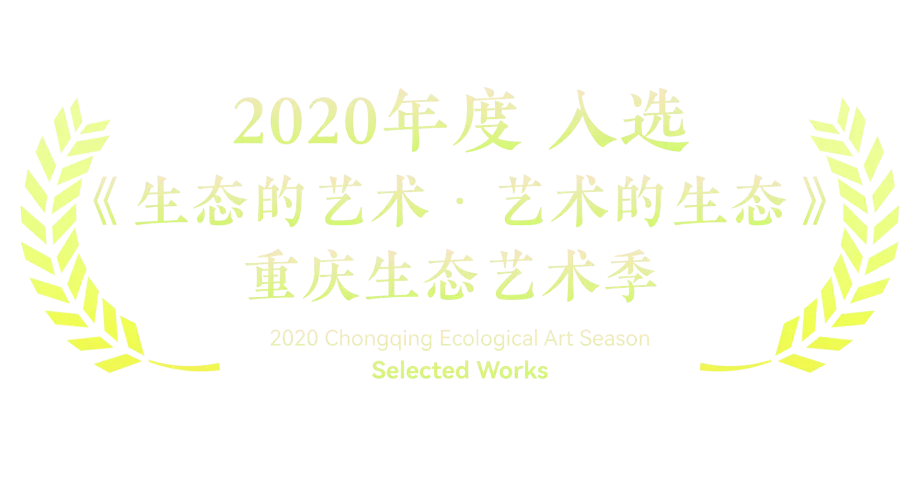
“来往”系列是我参与发起并实施的社区参与式艺术行动。作为艺术族群与社区在地社群共议共创的参与式艺术项目。项目发起缘起于我发现社区中有不少被人忽视的灰色空间,这些灰色局部能否可以像散布社区中的「无主」的椅子一样,能够被居民们默认为公共用品随时取用?
随着深入的社区田野考察,我与在地的部分商家通过制定价值交换规则,以达成“君子契约”:艺术家团队以店铺面貌或社区的灰空间为创作平台,与在地居民或者商家共创,为空间定制“升级”方案。原社区内的灰色空间将被以艺术创作的方式与巧思焕新,正式成为社区的“共享空间”,合作的商家或居民未来需要肩负维护该“共享空间”所带来的全新公共功能。通过如此类似的“契约”,艺术家团队希望能够让设计、艺术作品以一种全新姿态进入社区文化或者用潜移默化的方式改变社区中的灰空间,尝试以一期一会的君子之约点亮社群间的自治互助的关系网,旨在发现身边之美。
The “Coming and Going” series is a community participatory art action that I initiated and implemented. It is a participatory art project co-created by art groups and local community groups. The project was inspired by my observation of numerous neglected grey spaces within the community, questioning whether these grey areas, like the “ownerless” chairs scattered throughout the community, could be assumed by residents as public goods available for use at any time.
Through in-depth field research within the community, I, along with some local businesses, established value exchange rules to reach a “gentleman’s agreement”: the artist team used the facade of shops or the community’s grey spaces as creative platforms, co-creating with local residents or businesses to customize “upgrade” plans for these spaces. The previously grey areas within the community would be renewed through artistic creation and ingenuity, officially becoming “shared spaces” of the community. The cooperating businesses or residents would then assume the responsibility of maintaining the new public functions brought by these “shared spaces.” Through such “agreements,” the artist team hopes to introduce design and art into community culture in a new way or subtly transform the grey spaces within the community, attempting to illuminate the web of autonomous and mutual aid relationships between community members with a once-in-a-lifetime gentleman’s agreement, aiming to discover the beauty around us.


Chapter1: “Home Door” 《家门》
通过观察空间,发现在现场的单元楼,从入口望进内部,直观感受是没有「光」。我作为外来者走进里面只剩下逼仄、紧张;可在此生活的居民更操心的应该是今天楼下市场的菜价如何。我们的“专业”面对现场的存续真实,对应现在艺术与社会的关系。在中国,艺术乡建或者社区艺术营建仅图“粉饰”而已吗?
The first work, “Home Door,” is an exploration of space, revealing the lack of “light” perceived when looking from the entrance into the interior of an on-site apartment building. As an outsider, entering leaves me feeling cramped and tense; yet, for the residents living there, their greater concern might be the day’s market prices downstairs. Our “professional” take on the existing reality on-site corresponds to the current relationship between art and society. Is art in rural development or community art construction in China merely for “beautification”?


我尝试在这样一个被审美“遗忘”的生活空间中,制造美术馆一般的“纯白空间”,但当走入单元楼入口后,会发现只有一个被粉饰的平面,原来单元楼内部的空间完全没有任何改变,白色矩形突兀的存在。
I attempted to create a “pure white space” reminiscent of an art gallery within this aesthetically “forgotten” living space. However, upon entering the building, one finds only a decorated plane, with the interior space of the building remaining entirely unchanged, the white rectangle existing abruptly.



由外入内,正是“回家”,中国人有“家观念”,“回家”往往意味深长,从个体的人甚至到偌大的文明都是如此。从单元楼入口静止向内看去,有且仅有纯白平面,两条矩形光束分割「家门」表里。如果你走入「家门」,发现是仅15平方米的粉饰与浩渺无序的日常经验。
From outside to inside, it signifies “returning home,” a concept deeply rooted in Chinese culture, where “returning home” carries profound meaning, applicable from individuals to the entirety of civilization. From the entrance of the apartment building, looking inward, there exists only the pure white plane, with two rectangular beams of light dividing the “home door” inside and out. If you step into the “home door,” you find yourself in a mere 15 square meters of decoration amidst the vast, unordered experience of daily life.

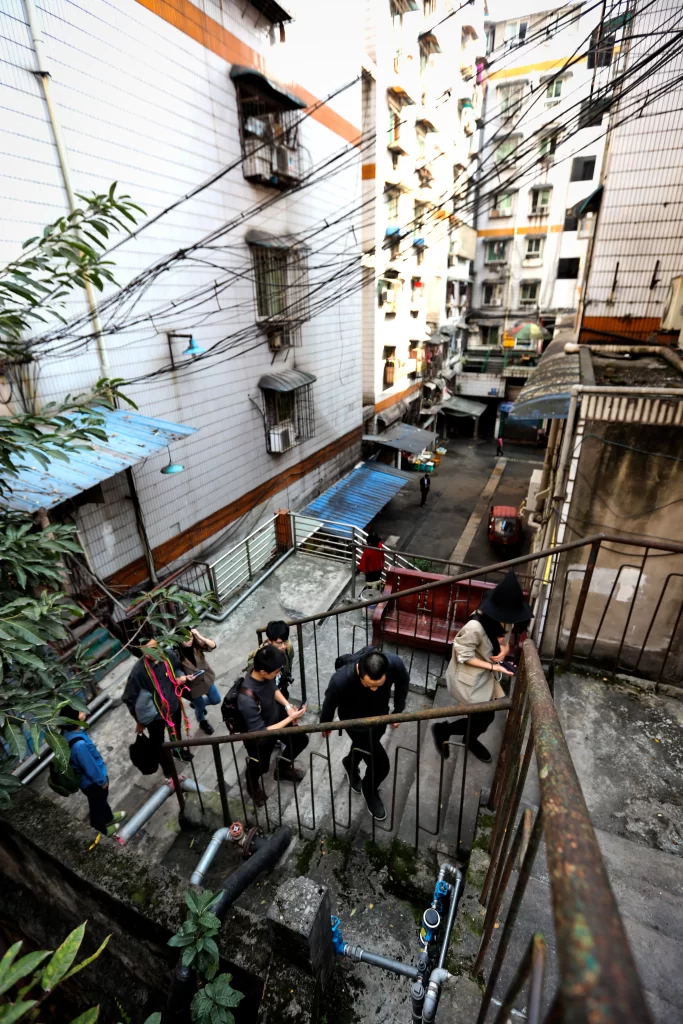
Chapter2: “It Starts Beneath the Feet”《始于足下》
整个社区的居民回家必须经过此地的楼梯,楼梯七弯八拐,走起挺费力。所谓回家更像是一个:从光明中曲折前行,到黑暗中垂直上升的过程。
The entire community’s residents must pass through this staircase to get home, a staircase that twists and turns, making the journey quite laborious. Going home seems more like a journey: moving from light into the twists and turns, then ascending vertically into darkness.
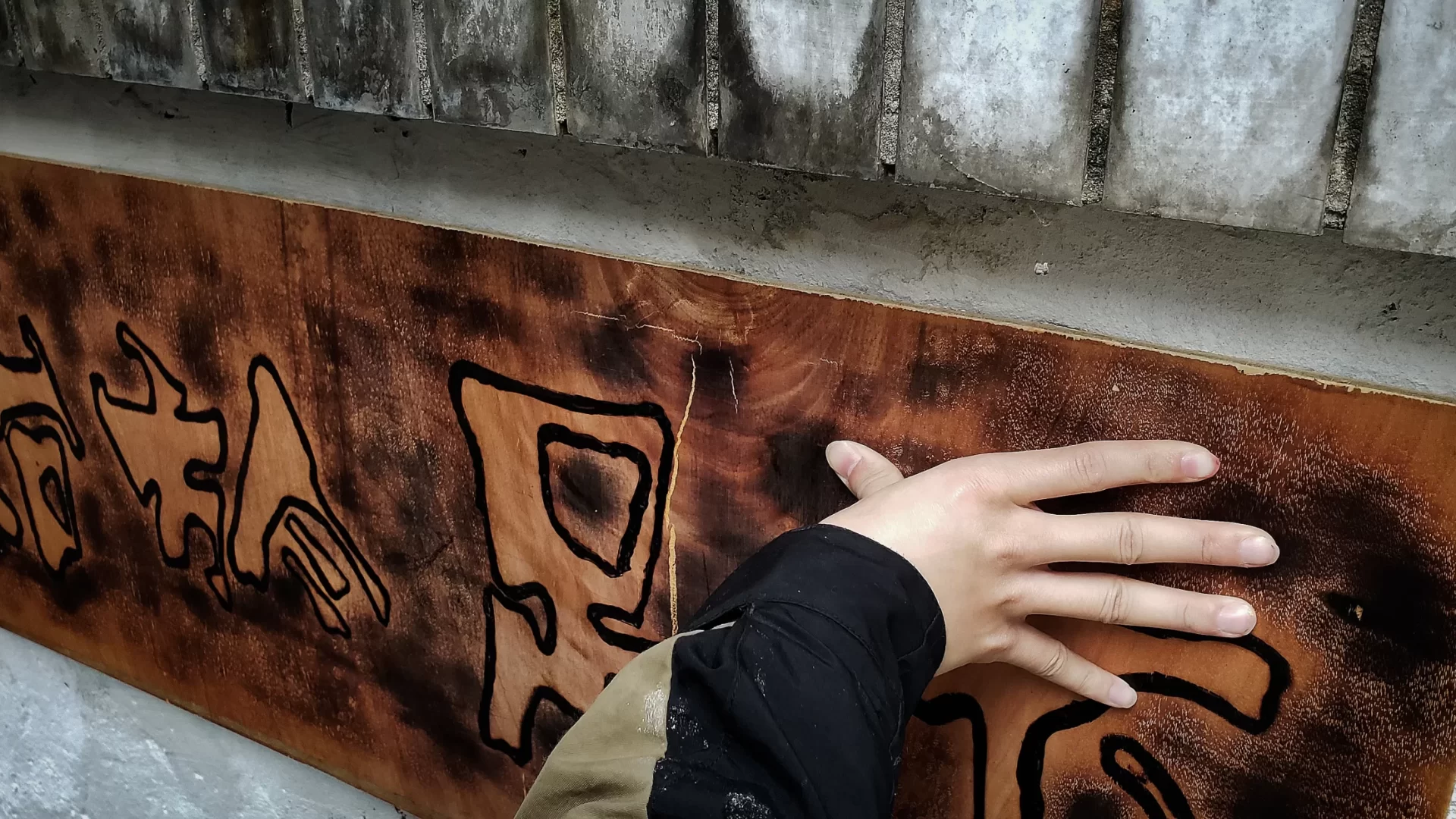
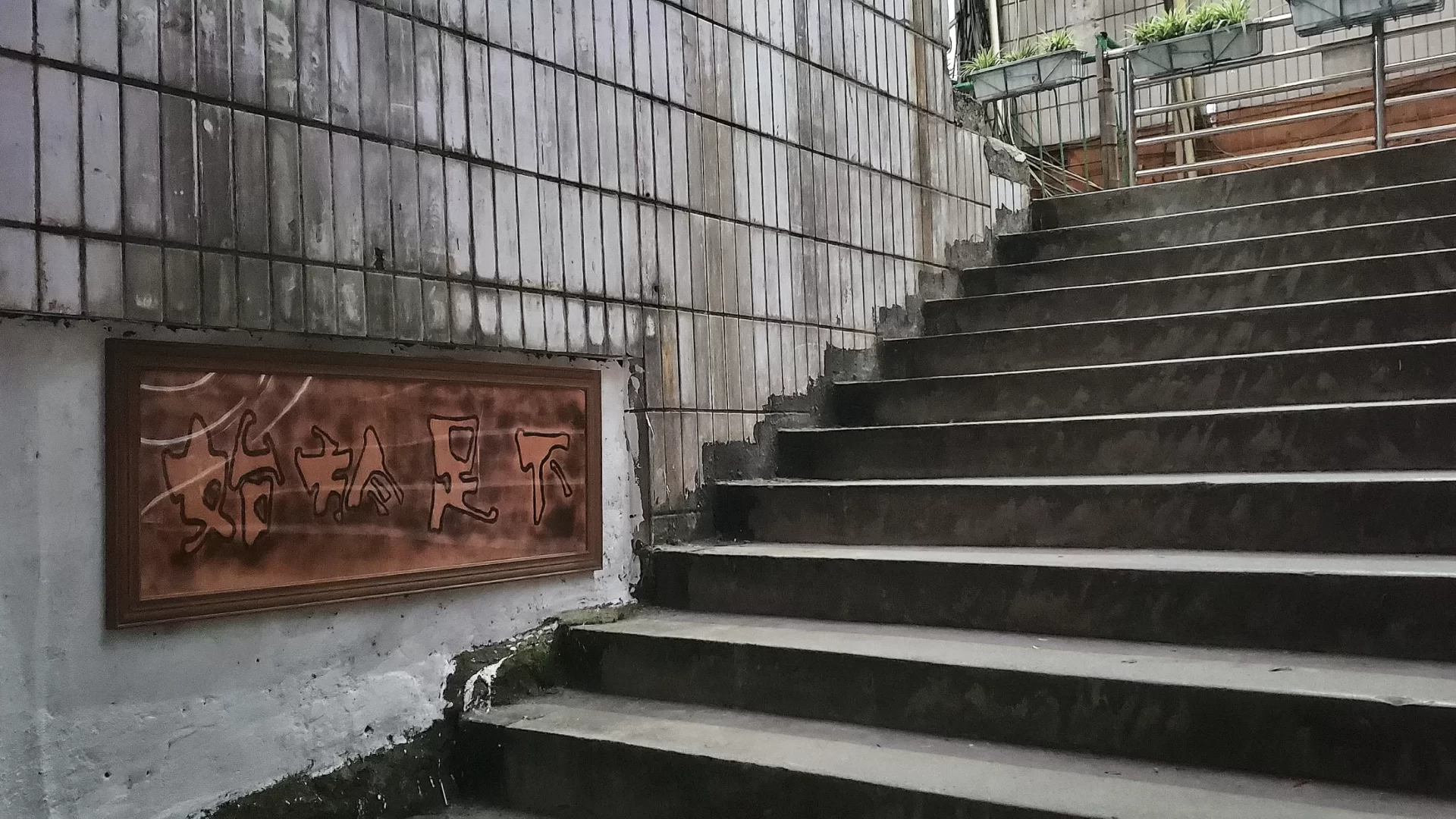
我在他们回家的路上,墙面的一个负空间里“藏匿”这一块牌匾:
“合抱之木,生于毫末;九层之台,起于垒土;千里之行,始于足下。”
On their way home, within a negative space on the wall, I “hid” a plaque:
“A tree big enough to embrace grows from the tiniest sprout; a terrace nine stories high rises from a mound of soil; a journey of a thousand miles begins beneath one’s feet.”


Chapter3: “Foot Repair”《修·脚》
在居民回家的楼梯上有这样一家特殊的修脚铺。
There is a unique pedicure shop on the staircase where the residents return home.


店主老板姓李,他是个哑巴,却经常能在社区里见到他和其他居民打打闹闹不亦乐乎。他的店铺简单得只剩下两张椅子和一个随拿随走的工具箱,依靠在墙上乱写画的文字作为“招牌”,可经过长达一个月的观察,事实上他的顾客都是社区里熟人。
The shop owner, Mr. Li, is mute but is often seen frolicking with other residents in the community. His shop is simply furnished with only two chairs and a portable toolbox, relying on scribbled words on the wall as a “sign.” However, after observing for over a month, it turns out that his customers are all acquaintances from the community.

我通过各种方式与老李“对话”,了解他对“招牌”的诉求与认识。
I communicated with Mr. Li in various ways to understand his needs and views regarding the “sign.”


最终用中国传统烙画技法,为这家“店”的老板烙制了无法“清洗”的广告招牌。市井文化与城市化进程之间的流弊,似乎昭示现代文明不太需要通俗浅近的意识流动。
Ultimately, I employed traditional Chinese pyrography techniques to create an indelible advertisement sign for the shop. The discrepancy between street culture and the urbanization process seems to indicate that modern civilization may not require the flow of common and superficial consciousness.


可我们的确应该在此处看到一家修脚铺。
Yet, indeed, a pedicure shop should be recognized here.

Chapter4: “A Promise Worth Its Weight in Gold”《一诺千金》
在不破坏小高发廊原有生态面貌的基础上,与店主高叔沟通,我们对店铺招牌进行了再设计,并在落地窗上贴上时尚造型剪纸。将原本的木质椅子,用黄金喷漆喷涂, 覆盖原有的破旧材质,呈现出金箔般的肌理。用同样的创作手法将发廊一角所及(包括高叔爱宠鹩哥的笼子)全用“黄金”覆盖,并专门点亮一盏夜灯,使其成为戏剧性现场。
Without altering the original ecological appearance of Xiao Gao’s barbershop, I communicated with Uncle Gao, the owner, and we redesigned the shop’s sign, adding stylish paper cutouts to the floor-to-ceiling windows. The original wooden chairs were spray-painted gold, covering the old material to exhibit a texture reminiscent of gold leaf. Employing the same creative technique, everything within a corner of the barbershop (including the cage of Uncle Gao’s beloved myna bird) was covered in “gold,” and a night light was specially illuminated to create a dramatic scene.
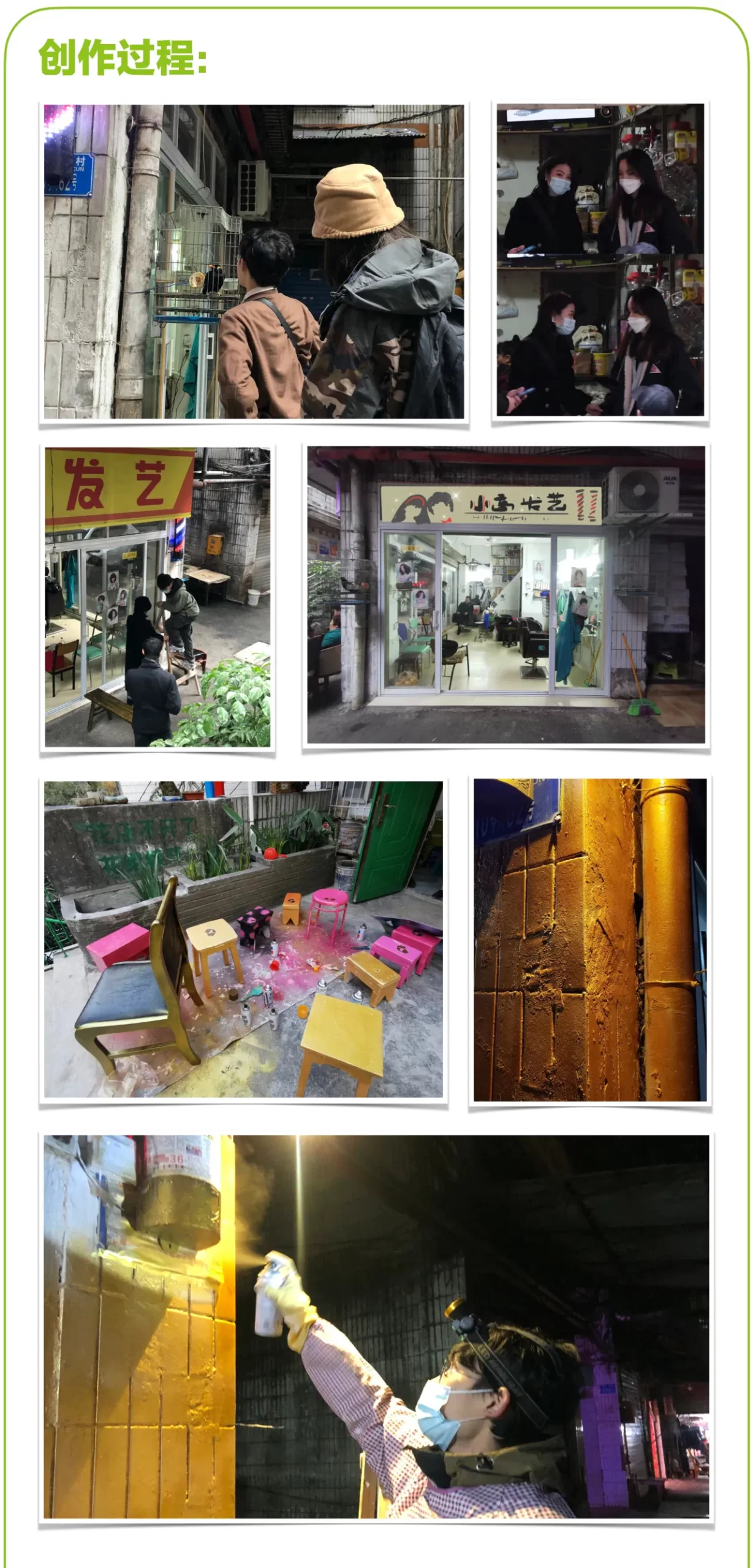

此处借用一诺千金的典故:“黄金千两,不如高叔一诺”。
This draws upon the idiom “A promise worth its weight in gold”: “A thousand taels of gold are not as good as Uncle Gao’s promise.”